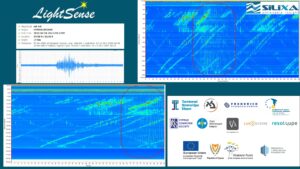Earthquake detection (M4.8) near Paphos on 26 April 2022, 19:11 UTC
Distributed acoustic sensing (DAS) is a powerful tool that allows a conventional optical fibre cable to be transformed into a dense array of strain seismometers. Silixa’s intelligent Distributed Acoustic Sensor (iDAS) uses the phase of Rayleigh backscattered light to demodulate dynamic strain events along an optical fibre. iDAS has a frequency range from millihertz to 50 kilohertz. It also offers the flexibility to operate on single-mode or multi-mode fibre without the introduction of any external or additional apparatus, with no loss of signal quality and while preserving the true acoustic nature of the measurement. This unique feature makes it possible to access legacy Distributed Acoustic Sensor (DTS) installations for new acoustic surveys, for example borehole seismic or flow measurements.
During our experiments, iDAS (located in Nicosia, EAC Head Offices) detected an earthquake (M4.8) near Paphos on 26 April 2022, 19:11 UTC. From the waterfall figures shown below captured at the time of the earthquake, we can recognize vehicles passing close to the fibre, which appear as straight lines with different orientations. On the other hand, seismic waves can be observed as quasi-vertical lines, as their velocity is extremely fast compared to normal vehicles.
The scope of LightSense project is the cable fault detection and localization, which is another application of iDAS. For example, when a flashover occurs, the temperature increases and a noise is created. Temperature increase can be detected through the use of DTS and the noise can be sensed by the iDAS system.
